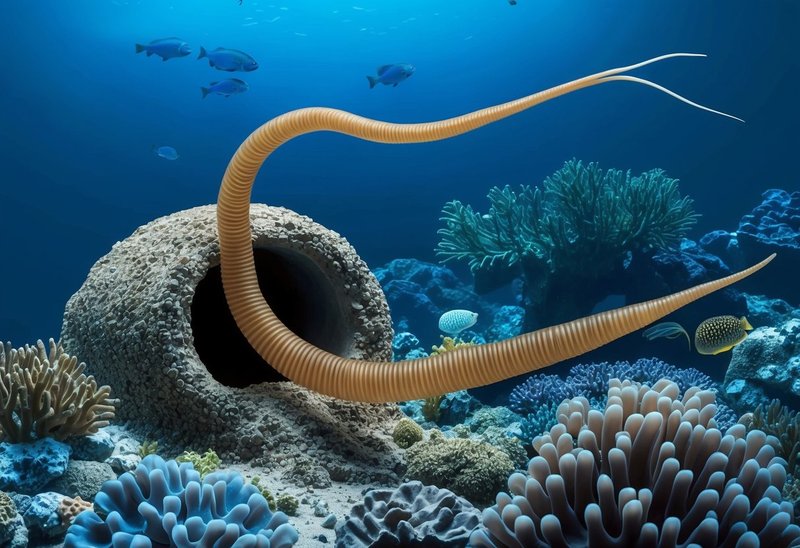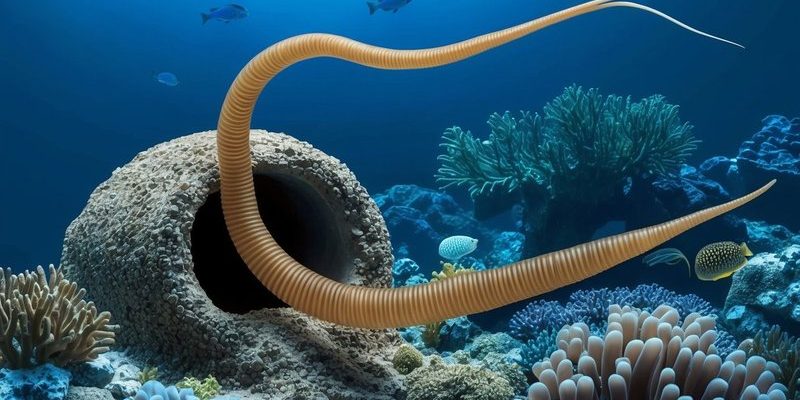
Bobbit worms, or *Eunice aphroditois*, are long, segmented worms that can reach impressive lengths—up to 10 feet! They hide in burrows, waiting patiently for unsuspecting fish or crustaceans to swim by. While they might seem a bit eerie, understanding how they affect their environment is key. Let’s dive in and explore the relationship between Bobbit worms and coral reefs.
What Are Bobbit Worms?
Bobbit worms are marine polychaetes that belong to the family Eunicidae. Their long bodies are often segmented, which makes them quite unique compared to other underwater creatures. They have powerful jaws and can strike quickly when prey comes too close. You could say they’re like the snipers of the sea—waiting for the right moment to take a shot.
Their vibrant colors can attract your attention, but don’t be fooled by their beauty. These worms are fierce predators. They primarily feed on fish and shrimp, which they catch using their sharp jaws. To put it simply, they have a pretty intense way of life, but how does all this impact coral reefs?
The Ecosystem of Coral Reefs
Coral reefs are some of the most biodiverse ecosystems on the planet. They provide a home for countless marine species, from tiny clownfish to majestic sea turtles. However, reefs are also fragile. A small change in the environment can have a big impact. You might think of coral reefs as bustling cities underwater, where every inhabitant has a role to play.
Corals themselves are made up of tiny organisms called polyps that build the limestone structures of the reef. These polyps rely on a delicate balance of light, water quality, and temperature to thrive. Any major disturbances—like pollution or overfishing—can stress out these corals and lead to problems like bleaching. So, how do Bobbit worms fit into this picture?
Are Bobbit Worms Predators or Prey?
Bobbit worms primarily prey on smaller fish and invertebrates. While this might seem harmful, they’re actually not a direct threat to corals. Instead, they typically target organisms that might be considered pests in the reef environment. This means that in some cases, Bobbit worms can help control populations of fish that could be detrimental to the corals themselves.
However, Bobbit worms can also be considered a part of the food chain. Larger predators, like sharks or moray eels, will prey on them. It’s like a balancing act in the ocean. If Bobbit worms became too numerous, they might affect fish populations, which in return could impact corals. It’s all interconnected!
The Impact of Bobbit Worms on Coral Health
Here’s the thing: while Bobbit worms themselves are not harmful to corals, their presence can signal underlying changes in the reef ecosystem. If you start seeing more Bobbit worms, it might indicate that other fish populations are declining or that the reef is facing stress. It’s like an early warning system for coral health.
Additionally, Bobbit worms create burrows in the reef, which can affect the structure of the coral itself. Over time, these burrows can weaken the coral, making it more susceptible to damage. So, while Bobbit worms may not be directly harmful, their activity can indirectly influence coral health by contributing to structural changes.
Bobbit Worms and Coral Reef Biodiversity
Biodiversity is vital for healthy coral reefs, and Bobbit worms play a role in maintaining that balance. By preying on smaller fish, they help ensure that the fish populations remain diverse. This is crucial because a diverse array of species can better withstand environmental changes. Think of it like having a team with varied skills; each member contributes to overall success.
Moreover, Bobbit worms can enhance the ecosystem in smaller ways too. Their burrowing activity can create spaces for other organisms to thrive. These areas can attract various marine life, which can impact the overall health of the reef community. It’s fascinating to see how everything in nature links together!
Signs of Imbalance in the Ecosystem
Unusual spikes in Bobbit worm populations could hint at ecological imbalances. When something disrupts the usual predator-prey relationships in a reef, it can lead to overpopulation of certain species, including Bobbit worms. This imbalance might stem from human activities, such as pollution, overfishing, or climate change, which all put stress on coral reefs.
If you’re diving or snorkeling and notice an unusual number of Bobbit worms, it might be time to consider the health of the reef. Are there fewer fish around? Are corals showing signs of stress? Monitoring these changes is crucial for conservation efforts.
So, are Bobbit worms harmful to coral reefs? Not directly. They are fascinating creatures that play a role in the complex web of life beneath the waves. They help regulate fish populations and contribute to the biodiversity of the reef. However, their presence can also indicate deeper problems within the ecosystem.
Understanding the delicate balance of life on coral reefs is essential for their protection. By keeping an eye on creatures like Bobbit worms, we can gain insight into the health of these incredible underwater cities. The next time you hear about Bobbit worms, know that they’re more than just quirky sea creatures; they’re a vital part of the marine environment that needs our attention and care.

